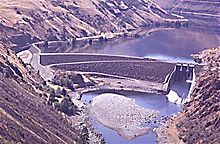Oxbow Dam facts for kids
Quick facts for kids Oxbow Dam |
|
|---|---|
 |
|
| Official name | Oxbow Dam |
| Location | Hells Canyon, Adams County, Idaho / Baker County, Oregon, USA |
| Coordinates | 44°58′15″N 116°50′04″W / 44.97083°N 116.83444°W |
| Opening date | 1961 |
| Operator(s) | Idaho Power Company |
| Dam and spillways | |
| Impounds | Snake River |
| Height | 175 feet (53 m) |
| Reservoir | |
| Creates | Oxbow Reservoir |
| Total capacity | 58,200 acre-feet (71,800,000 m3) |
| Catchment area | 73,300 square miles (190,000 km2) |
| Surface area | 1,150 acres (470 ha) |
| Power station | |
| Installed capacity | 190 megawatts (250,000 hp) |
| Annual generation | 1,047 gigawatt-hours (3,770 TJ) |
The Oxbow Dam is a large structure built on the Snake River. It sits right on the border between Idaho and Oregon, in a deep canyon called Hells Canyon. This dam helps create electricity using the power of flowing water. It's a "run-of-the-river" dam, which means it uses the natural flow of the river rather than storing huge amounts of water in a giant lake. The Oxbow Dam was finished in 1961. It is part of a bigger project called the Hells Canyon Project, which includes two other dams: Hells Canyon Dam and Brownlee Dam. The Idaho Power Company built and operates all three dams.
What is the Oxbow Dam?
The Oxbow Dam is a type of dam called a rockfill dam. This means it's built mostly from rocks and earth. Its main job is to produce hydroelectric power. This is a clean way to make electricity using the force of water.
How Oxbow Dam Makes Electricity
Inside the dam, there's a special building called a powerhouse. This powerhouse has four big machines called generating units. These units work together to produce a lot of electricity. They can make up to 190 megawatts (MW) of power. This is enough electricity to power many homes and businesses.
Impact on Fish Migration
The Oxbow Dam, along with the other two dams in the Hells Canyon Project, affects fish. These dams do not have special passages for migrating fish like salmon. Salmon are anadromous fish, meaning they are born in fresh water, live in the ocean, and then return to fresh water to lay their eggs.
Because of these dams, salmon cannot swim upstream past Hells Canyon Dam. This blocks their natural journey to parts of the Snake River where they used to lay their eggs. There is a natural waterfall called Shoshone Falls further upstream that also stops fish from going higher into the Snake River basin.

